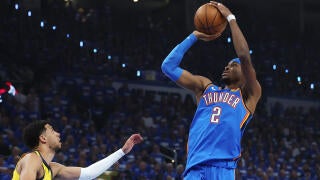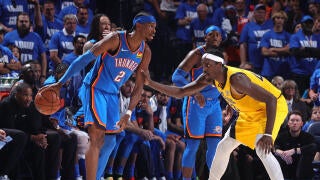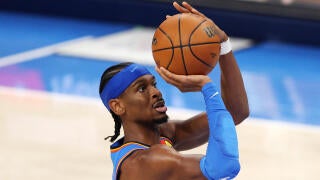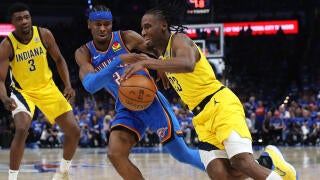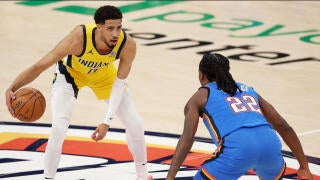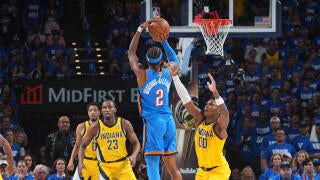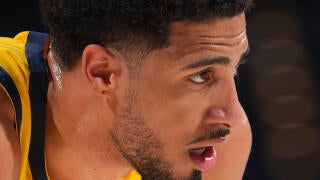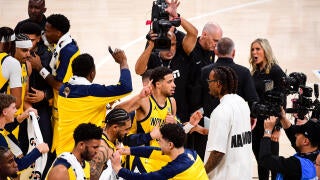The Oklahoma City Thunder once again were in control against the Indiana Pacers in Game 2 of the 2025 NBA Finals on Sunday. This time they stayed in control for all 48 minutes. The Thunder won Game 2 comfortably, 123-107, to even the best-of-seven series 1-1. The Thunder bounced back for the victory after coughing up a 15-point fourth-quarter lead in Game 1 on Thursday. Shai Gilgesous-Alexander led the way with 34 points and eight assists, and five different OKC players scored at least 15.
Tyrese Haliburton, who hit the heroic game-winner for Indiana in Game 1, had a quiet night. Haliburton was held to five points through three quarters (he ended with 17 after coming alive in the fourth).
The Thunder stepped on the gas in the second quarter, using a 35-9 run to open up a lopsided lead. Chet Holmgren made his presence felt after a lousy Game 1, scoring 15 points. Jalen Williams added 19, while Alex Caruso (20 points on 4-of-8 3-point shooting) and Aaron Wiggins (18 points on 5-of-8 3-point shooting) both had big games off the bench.
The series now shifts to Indiana for Games 3 and 4 on Wednesday and Friday. Here our biggest takeaways from Game 2.
Is this Haliburton, or is this Oklahoma City's defense?
Ignore the game-long stats for Tyrese Haliburton. Most of his numbers were accumulated in a mostly non-competitive fourth quarter. He had five points and four assists in the first three quarters. While he made the biggest shot of Game 1, he also finished the game with 14 points and six assists. On an individual level, the Finals have been a struggle for him thus far.
The question here is whether this is his own issue or just an inevitability of the defense he's facing. Haliburton, statistically at least, tends to have a dud at least once per playoff series. He's completed six series as a member of the Pacers and has at least one game with 10 or fewer points in all of them. But just think about how every other star guard the Thunder have faced this postseason have fared against them.
Anthony Edwards lost almost five points per game off of his regular-season scoring average against Oklahoma City. Jamal Murray's field goal percentage plummeted by over six percentage points. Ja Morant's fell nearly as far despite his claims that he'd figured the Thunder out. Oklahoma City has three All-Defense-caliber guards alone. That says nothing of their bigger players. When they set out to stop an individual player, that player tends to be stopped.
But does it even make sense to judge Haliburton on that standard? So much of what he does is intangible. He controls the flow of a game on offense and can genuinely dominate with five points. Yet his two single-digit scoring outputs this postseason both came in losses. The same was true a year ago. There is a middle ground here. Haliburton's performance is too complex to be boiled down strictly to individual numbers, but he has to be able to create his shot at a higher level than he has thus far if the Pacers are going to win this series.
Oklahoma City's depth is just unfair
If Aaron Wiggins was on a normal team, he'd be treated as a prized young player, a cornerstone they'd want to build around for the foreseeable future. He plays for the Thunder, so he's an eighth man. He played only nine minutes in Game 1 of the Finals. In Game 2? He outscored every player on Indiana's roster with 18 points. Oh, and he wasn't even Oklahoma City's highest-scoring reserve. That would be Alex Caruso with 20 points.
That's what the Thunder can do to you. A normal team relies on its bench to play just enough to get rest for its starters. A typical contender might have one or two truly useful bench weapons. But the Thunder are so deep that they can swing a Finals game with someone they barely used three days earlier and get a 20-piece out of their bench defender.
What's so scary about the proposition are the steps the Thunder have taken to make sure the apron doesn't deprive them of this depth. Wiggins is locked into a five-year contract he signed last summer. His salary actually descends in each of the next three seasons before the Thunder have a team-option on his fifth. They signed him so early that he and the league didn't realize how valuable he is. It's a tactic they pulled with Isaiah Joe and Lu Dort as well, and one they'll likely use again in the future. What happened on Oklahoma City's bench in Game 2 was not a fluke. It was the standard, and it will be for years to come.
The Thunder remembered they're big
There was quite a bit of surprise in Game 1 when the Thunder pulled Isaiah Hartenstein out of the starting lineup in favor of Cason Wallace, but the move actually made sense. The Pacers have killed two-big lineups all postseason. The real issues came in both Oklahoma City's playing style and in its division of minutes. They didn't just abandon the two-big look. They played seven minutes, including the critical, game-losing stretch at the end, with no centers on the floor.
Wallace remained in the starting five for Game 2, but everything the Thunder did defensively hinged on their size. They used the big men more, and even together for a smidge, but they also took advantage of them more intentionally. They were comfortable letting Hartenstein and Chet Holmgren drift off of Indiana's big men and daring them to shoot jumpers. The benefit of doing so was having far more defense at the rim. The Pacers scored only 34 of their 107 points in the paint. The Thunder outrebounded the Pacers by eight.
The Thunder don't have to win this series with their biggest possible lineups, but size is an advantage for them. They actually took advantage of it in Game 2, and lo and behold, they won the game easily.



